Recent posts
September 28th, 2021
Is Flambient or HDR the best real estate photography technique?
All posts

Aug 19 2021
Is Flambient or HDR the best real estate photography technique?
When it comes to shooting real estate, chances are you have heard of the two most common techniques which are Flambient (Flash and Ambient) and HDR. Both can produce decent quality and captivating images.
Both techniques offer distinct advantages and they work differently for different photographers. You can always try experimenting to see what suits you best, what style you want to pursue and on which to build your signature quality.
Today we are focusing on the two aspects of creative control and editing time between auto merged HDR, manually merged HDR and Flambient to find out which is our winner.
Auto merged HDR
Auto merged HDR images are done by bringing a bracket of input photos into editing software like Aurora HDR, Adobe Lightroom, Luminance HDR and others, and running an auto HDR merge. Some photographers prefer using the Auto Merge built-in feature of Lightroom, others prefer plug-ins such as easyHDR or Photomatix Pro. There are quite a few tools for you to try and choose.
The key advantages when using these tools are quick to finish your work and ease of use. All you need is to run an auto merge on the input files, do a bit of light editing and then simply export. Fast and straightforward. You could have the images ready in a fraction of the time it takes to make all those adjustments yourself.
Sometimes, you might go the extra mile editing window masking or color correction, but for the sake of comparison here let’s keep it at a basic editing level.
The downside to this approach is that quality is not necessarily the highest or what you were expecting. Even with satisfactory output, it can present the “HDR” look of being over-processed, texture-flattened, unnatural, or lackluster contrast. Plus, auto merged HDR images can suffer from multiple color casts and inaccurate color rendering.
Hand blended HDR
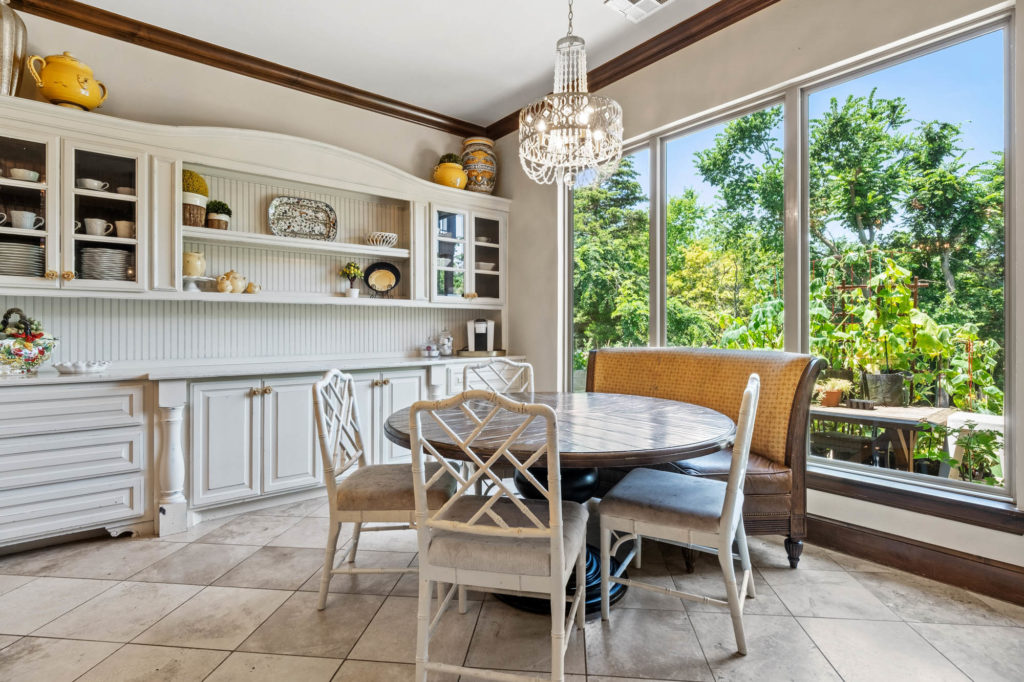
Auto merged HDR takes all the bracketed photos and averages captured image data, which often includes unnecessary info. However, the manual blending method does eliminate that issue.
As you might expect, it takes a considerable time, but in return, the result is often closer to what you need. Although, when you shoot five brackets, you might need only two or three often producing good enough results to make a nice, merged file.
Here, the primary advantages include greater control over the look of the final image as you have a choice of which aspects and elements of each of the bracketed images to incorporate and retain, and which to eliminate from your final composite. Thus, you can achieve a more natural, less processed “looking” image in higher quality.
The minus points? Clearly, this editing process requires more time and effort to get things done well. As an almost immutable rule, the better quality image you require, the more work needed with window masking, color correction, etc. Still, you can reduce some of the editing time by utilizing a few common features and presets in the app you use.
Flambient
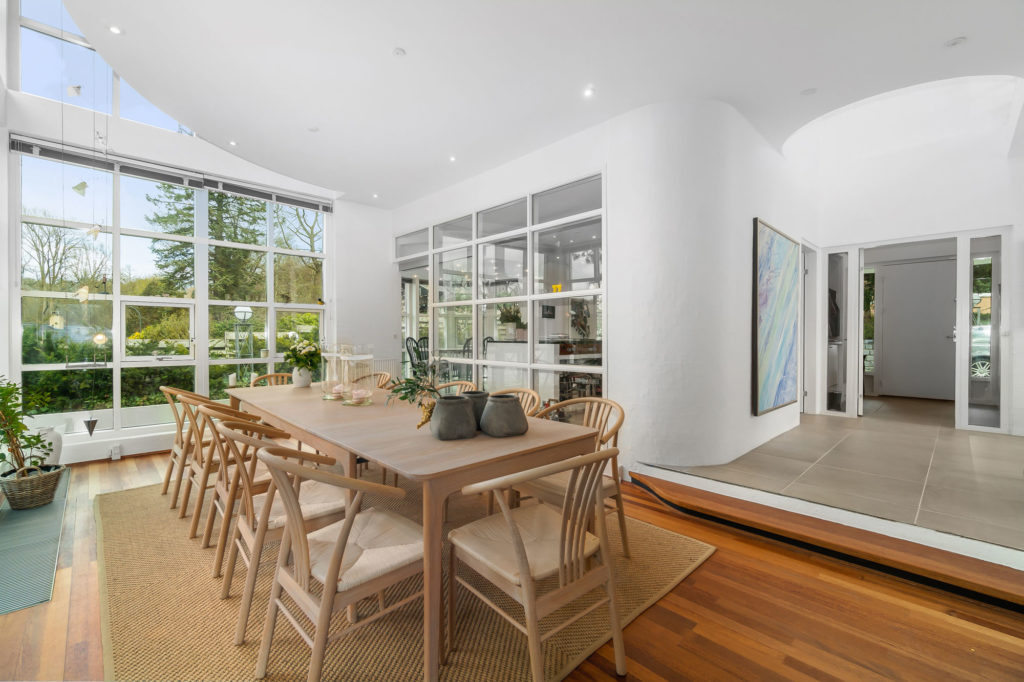
This is a distinctly different shooting technique that allows room for creativity and artistic exploration. You can use as many flashes and ambients as you like.
The greatest benefit of flash in real estate photography is the high accuracy of color representation. By bringing the ambient light into the room with the flash, it wipes out most color casts present in the shoot. With editing, just like manual blending, you have better control over the look of the final images and an even more natural feel thanks to the ambient layer.
The disadvantage of this method? It is usually the most time-consuming and technique demanding. You must correctly use lighting equipment for each shot, meaning you will need a bit of trial and error to get things right. And given the necessity for lighting equipment here, there is of course more gear you will need to invest in.
Featured solution: https://imagelife.app/product/image-enhancement/
So what? Flambient is the king
With all those pros and cons, we do have a winner – Flambient. This technique gives you all the merits of hand blending HDRs but with more accurate color representation thanks to the lighting/flash control. While it does take more time to shoot and produce the final composite, once you get the hang of things you will most likely find it the most appealing for you and your clients.
Finally, we would not want to sign off without noting that image quality is not the only contributing factor when it comes to choosing which technique works best for you. Realtors will normally be careless about your technique choice and never compare images like we did today. They only want the best possible images, either Flambient or HDR. As a photographer, you could experiment with different approaches and see what works best for you and your clients.
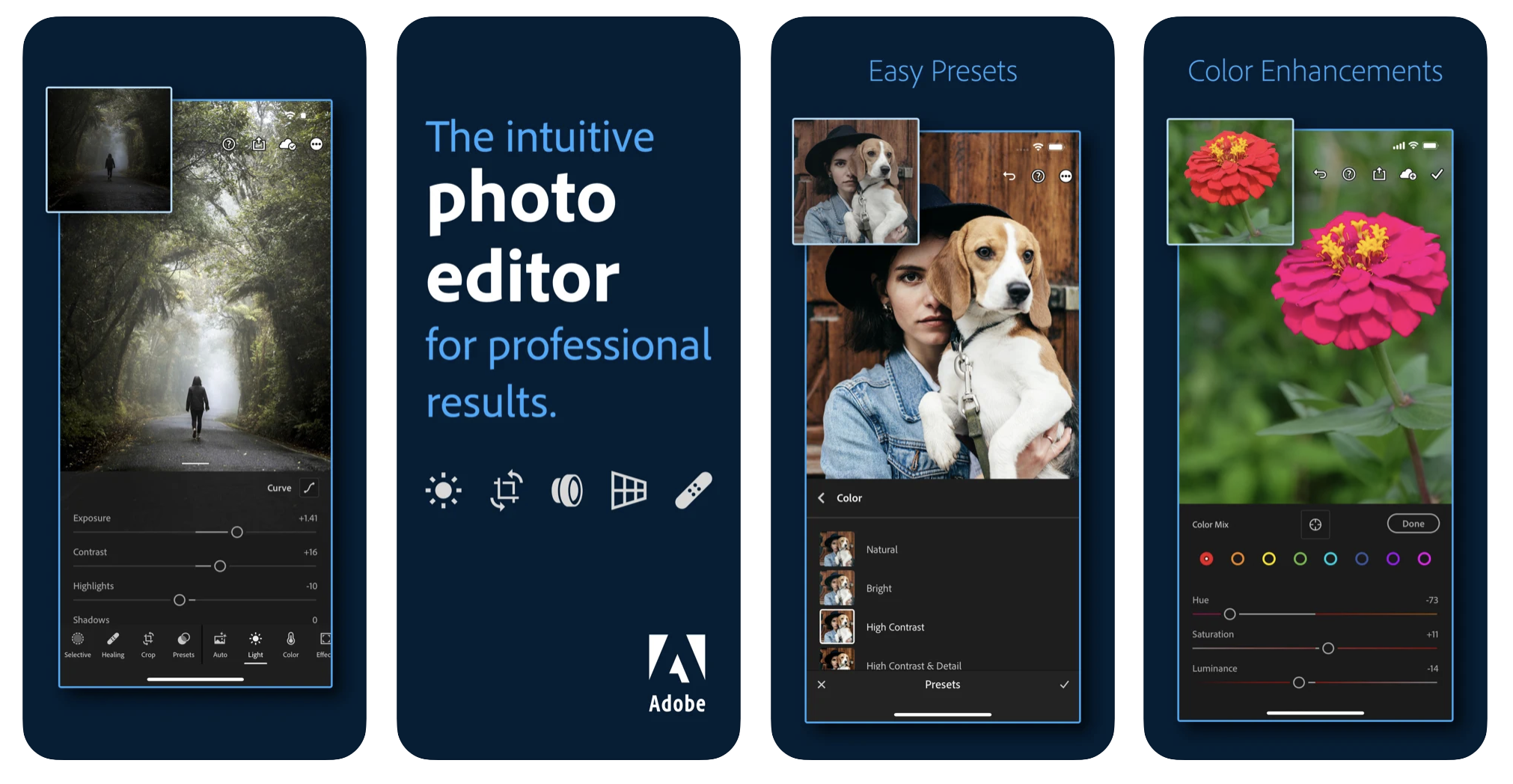
Aug 19 2021
5 best photo editing apps on mobile
Looking for some best photo editing apps for your freshly taken real estate images? You’ve gotta try these apps!
Taking photos with a smartphone has always been a fun habit many photographers enjoy. It’s easy, convenient and the edit is so good too. You can perform professional editing on desktop always but a mobile app works wonder for a nice, quick image for your social media update or messaging clients. If you are finding a photo editing app on mobile where you can do easy but powerful edits, this blog is right for you.
Let’s delve into some of the most widely endorsed photo editing tools on earth here.
VSCO
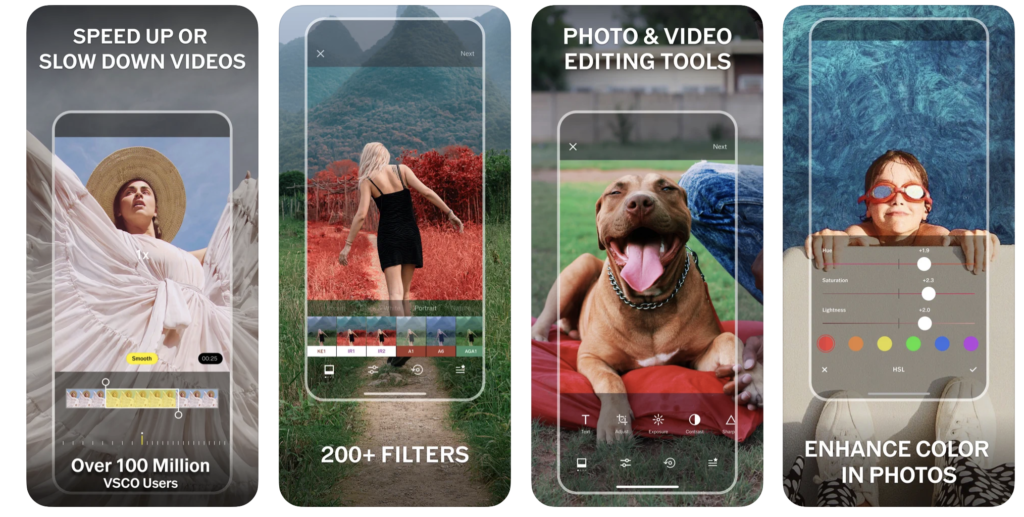
Similar to Instagram, VSCO enables built-in camera function, editing tools and even an online community of photographers, from amateur to professional. Above all that, the software is most known for its wide range of classy, stunning filters.
If you are fond of analog film camera and want to create an “analog” vibes for your photos, VSCO is your go-to. Unlike some heavily filtered Instagram presents, VSCO’s filters are delicate and subtle, making the photos look almost natural. The strength (you can call it opacity in photoshop terms) of those filters can be easily adjusted with a slider.
The free versions have almost basic editing features like contrast, saturation, exposure, … But what else is cooler? With just 4 Starbucks coffees ($20) for once, you can be a premium member to enjoy 200+ presets and advanced editing functions such as HSL, applicable for both images and videos.
Lightroom
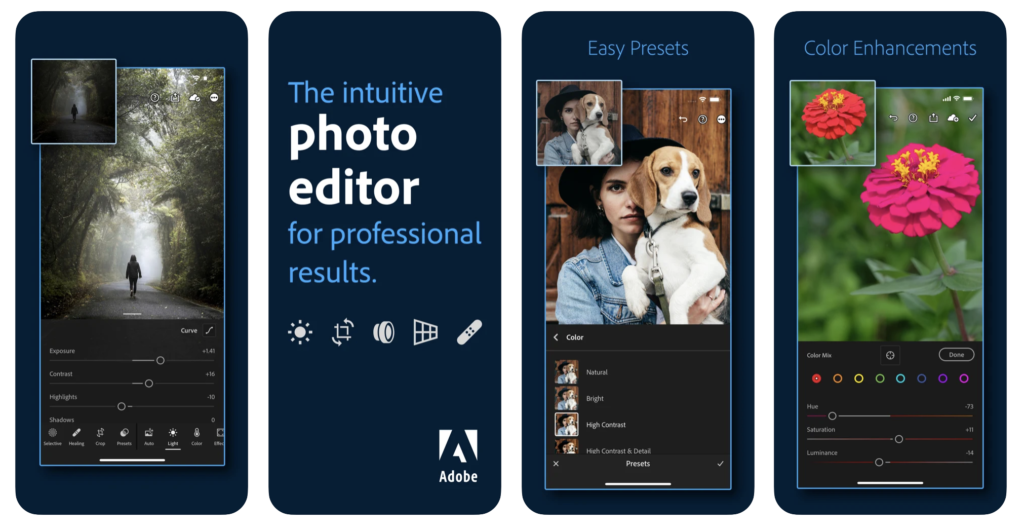
No stranger to Adobe Lightroom on desktop? Have you ever tried its mobile version available on both iOs and Android.
The tool is a powerful photo editor and camera app to help you capture and edit professionally on the go. It works well with RAW files, full-resolution photos so you can have grain control over it and enjoy the benefits of “high quality input”.
The premium version, comes at a cost of $5 per month, offers over 70 exclusive presets created by many pro photographers so you can use and twist it your way. Available with premium subscription are selective editing and Adobe Sensei – an AI system that tags your images based on their content automatically so you can easily search and manage your files.
Adobe Photoshop Express
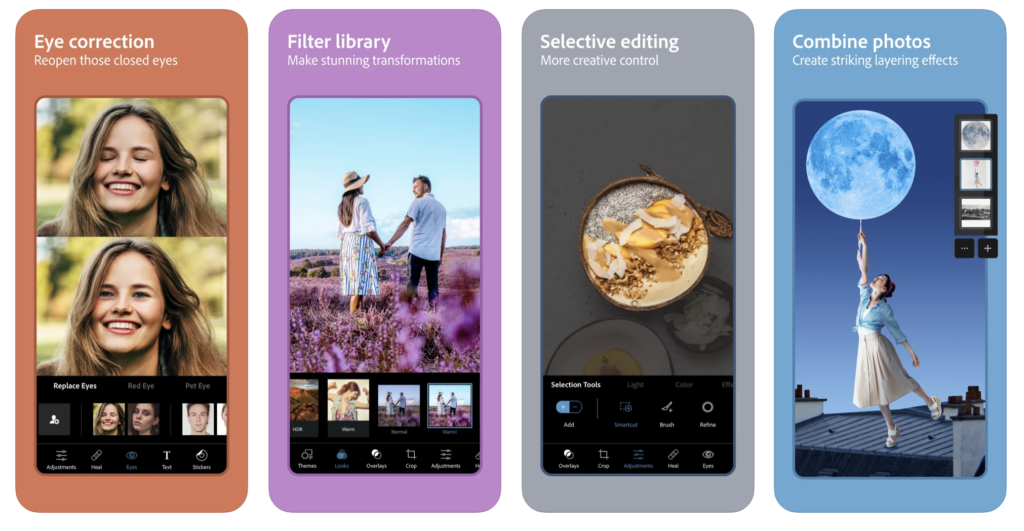
As the name suggests, Adobe Photoshop express inherits most of the Photoshop features and functions but at an express level, which enables users to work quickly and easily on a small touchscreen.
You can either upload photos from your device, take a new one with camera or work directly on your Creative Cloud account for editing. To use the app from the get-go though, you have to sign up for a free adobe creative account.
A subscription from $5 per month allows you to enjoy all the editing functions from basic to advanced, red-eye correction, brightness, contrast, saturation, filters, borders. Nonetheless, the coolest part is the selection of smart filters that automatically corrects common issues like uneven color temperature or poor exposure.
Snapseed
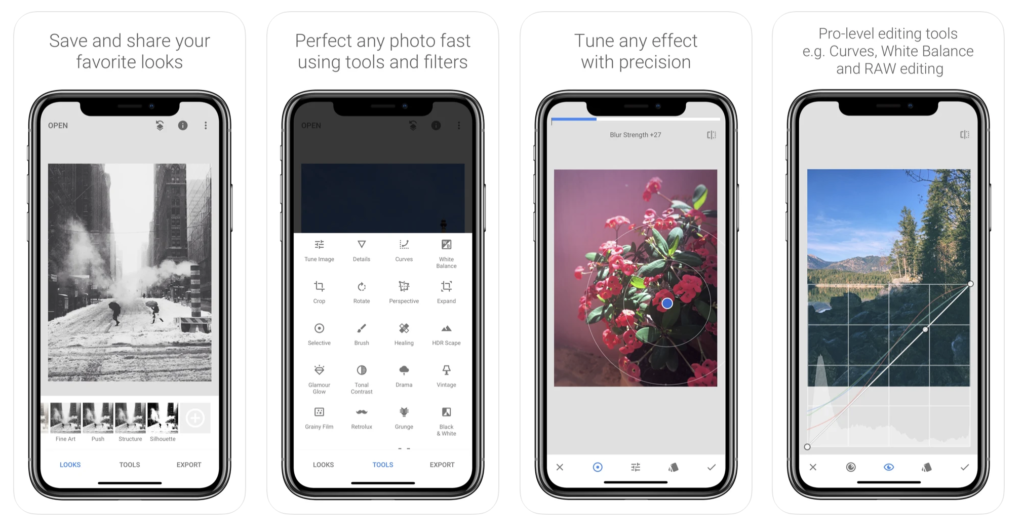
If there is a completely FREE-TO-USE ‘version’ of Adobe Photoshop, it must be Snapseed by Google. This photo editing app packs a punch and it offers a massive range of features with a highly user-friendly interface. As you might expect, this app comes with a number of preset filters for you to edit, adjust. You can also create your own from scratch and save for later use.
Most classic tools including cropping, straightening, frames, vignettes, sharpening, graining are available in the app. Plus, Snapseed has precision masking to let you edit the depth of field to bring out blurry effects when needed. Also, it has some selective adjustment tools to let you retouch a specific corner of the image such as removing blemishes on the wall or brighten specific spots.
Your history of editing changes is saved so you can alternate, flip back to the previous edit every time you go a bit over what you want. Finally, you can directly modify original image in your camera roll with the changes made. That way, there’s no need to export and have two images separately. Still, you can save your edits as separate image.
Photoleap by Lightricks
iOS only
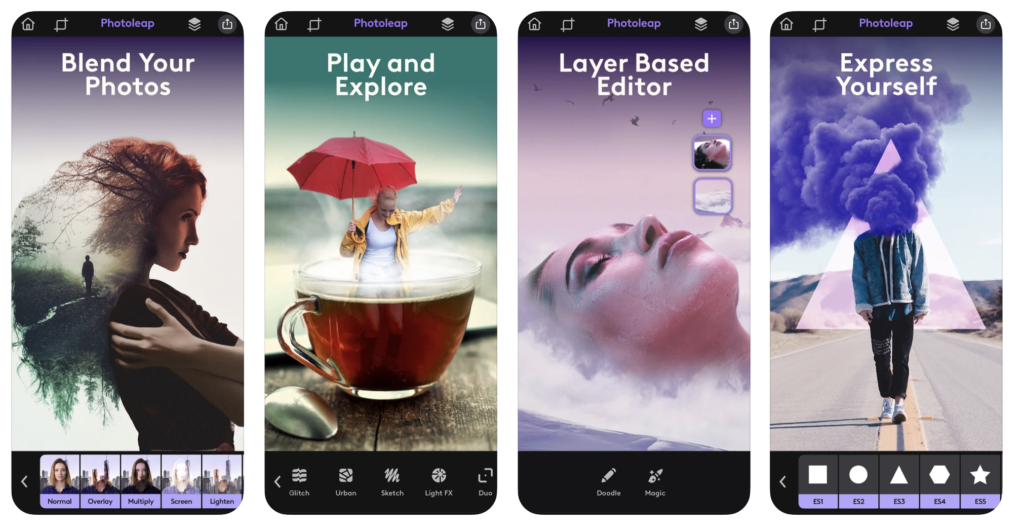
The Apple Design Award 2017 Winner is here. Photoleap by Lightricks (formerly Photofox) is the ultimate app for creativity and sophisticated artistic work.
The most popular feature of this app is it allows users to blend photos together to create multi-exposure effects or blend movements into static images for cinematic effects. Plus, you can further find a range of graphic elements, text and such animations within the app to max out your creativity.
However, the free version only allows you to use two layers simultaneously so you would want to subscribe to its premium pack ($2.74 per month or a one-off fee of $64.99). The app indeeds has an abundance of features and functions so if you want to make the most of it, a bunch of tutorial videos are at your disposal. It takes time to master this tool.
Conclusion
There you have it, the five great tools for photo editing on mobile. Snapseed by Google is the free app for most editing, retouching and color blending you might ever need. However, if you prefer professional editing as you do on desktop, Photoshop’s Lightroom and Photoshop allow you to work directly on your Adobe Creative Cloud with small monthly fees. Passionate about creative visuals and effects, Photoleap by Lightricks is the one you should try. Finally, when you want to have more natural and film-like filters, VSCO app is the one for you, its 200 filters applicable on both images and videos will be worth your $20.
Let's stay in touch.
Subscribe and be the first to know!
[contact-form-7 404 "Not Found"]





